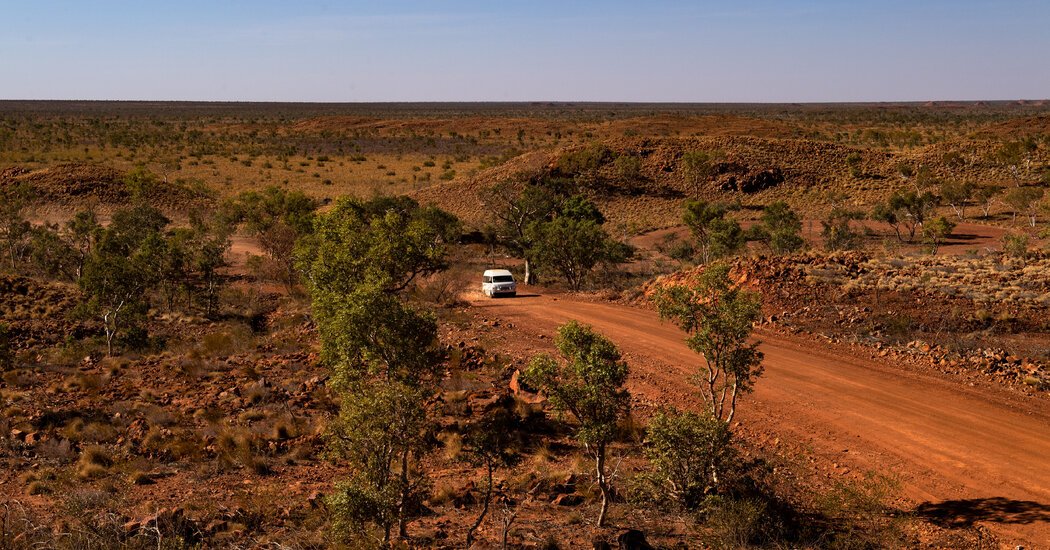
The Australia Letter is a weekly newsletter from our Australia bureau. This week’s issue is written by Julia Bergin, a reporter based in the Northern Territory.
Driving through Central Australia can be a battle with dust, floods, fires, collapsed roads and network failures. And when the cargo is food, even a minor setback can have serious repercussions.
The remote Indigenous community of Lajamanu was set up in the Northern Territory by the Australian government in 1949. Dozens of people, already displaced from their traditional homes, were moved there from another community about 350 miles away because of overcrowding and water shortages.
Today, Lajamanu has a population of about 800. Like many other remote communities in Australia, it is sustained by a single store that sells everything from food to diapers to washing machines. The store is supplied once a week, sometimes every two weeks, by truck drivers who have to contend with the region’s harsh conditions and treacherous infrastructure.
For the first few months of this year, the only road into Lajamanu was cut off by a combination of record rainfall, storms and flooding. The regular deliveries stopped, and stocks of food, water, medicine and other essentials began to dwindle. The community, said Andrew Johnson, a Warlpiri man and Lajamanu elder, was suffering, particularly from the lack of food.
“No strength, no energy,” he said.
Under government policy, the store should have been prepared for such an outcome, given the predictability of the annual wet season. As things got worse, residents and suppliers repeatedly appealed to the government of the Northern Territory to declare an emergency.
“The silence was deafening,” said Alastair King, the head of the Arnhem Land Progress Aboriginal Corporation, or A.L.P.A., a nonprofit organization that operates the Lajamanu store and others in remote communities. “They didn’t respond, didn’t tell us what it would take to declare an emergency and didn’t tell us why it was not declared an emergency.”
So A.L.P.A. organized special trucks and small daily charter flights to bring in supplies. It ended up doing so for months — spending more than 350,000 Australian dollars, about $232,000 — but the Lajamanu store’s shelves stayed mostly bare.
“I was expecting the big army plane, the Hercules, to bring all the food, but all I saw was the one-engine air charter going backward and forwards dropping little bit by bit,” Mr. Johnson said. “It wasn’t enough. It wasn’t treated as an emergency and taken seriously.”
Similar situations were unfolding about 500 miles away in the remote Indigenous community of Minyerri, also known as Hodgson Downs, and 750 miles away in another, Borroloola, both of which had also been cut off by flooding.
In Borroloola, food stocks were dwindling, panic buying was reported, cash withdrawals were limited and there was no phone service or network coverage, making credit card payments impossible. In late March, months after the first appeals for help were made, the military was brought in to help evacuate Borroloola residents. The Northern Land Council, which represents Indigenous people in the region, said the response to the disaster by the federal and Northern Territory governments had been “appalling.”
The subsistence supply model is the norm in most remote Indigenous communities. It’s the product of decades of interventionist policy that moved people from their traditional homelands. Now, whenever food security is threatened by supply chain issues, locals are forced to appeal to the government for help.
In Lajamanu, three months after the regular truck deliveries stopped, an A.L.P.A. employee told the territorial government in an email that the community was in a “very critical” state. There were no eggs, shelf-stable milk, frozen meat or toilet paper.
A spokesperson for the Northern Territory government said a “food security plan” was put into effect in late March, two days after the A.L.P.A. employee’s email was received, including government-funded daily charter flights that brought in supplies until the roads were usable again.
Mr. King said the government started paying for flights only after a personal appeal was made to Chansey Paech, the attorney general for the Northern Territory. Mr. Paech declined to comment.
An underlying cause of the crisis, Mr. King said, was the government’s failure to ensure that roads can withstand the wet season. Pointing to photos of muddy, collapsed and completely submerged roads, Mr. King said the result had been hundreds of people trapped and going hungry.
“If that’s not an emergency, then what is?” he said.
Now here are our stories of the week.
Are you enjoying our Australia bureau dispatches?
Tell us what you think at NYTAustralia@nytimes.com.
Like this email?
Forward it to your friends (they could use a little fresh perspective, right?) and let them know they can sign up here.






